
|
Now it is bright as 10.0 mag (Dec. 5, Juan Jose Gonzalez). It is observable all night in the Northern Hemisphere. In the Northern Hemisphere, it stays observable in excellent condition for a long time. In the Southern Hemisphere, it will never be observable again after this. It started fading before the peirhelion passage.
Date(TT) R.A. (2000) Decl. Delta r Elong. m1 Best Time(A, h)
Dec. 9 0 42.98 86 44.9 1.021 1.683 114 10.1 20:51 (179,-32)
Dec. 16 23 44.68 86 25.5 1.083 1.729 113 10.4 20:57 (177,-32)
|
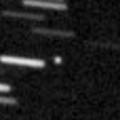
|
Now it is very bright as 11.7 mag (Dec. 8, Katsumi Yoshimoto). It will approach to Earth down to 0.07 a.u. in mid December, and it will brighten up to 10 mag. In the Northern Hemisphere, it stays observable in excellent condition until mid December. In the Southern Hemisphere, it stays low.
Date(TT) R.A. (2000) Decl. Delta r Elong. m1 Best Time(A, h)
Dec. 9 5 50.53 43 20.6 0.163 1.137 157 11.6 0:46 (180, 12)
Dec. 16 1 24.67 35 36.6 0.071 1.027 125 10.5 20:57 (157, 19)
|
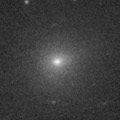
|
Now it is 11.2 mag (Dec. 4, Thomas Lehmann). It stays 11 mag until December. It is observable in good condition in the Northern Hemisphere. It locates very low for a long time in the Southern Hemisphere.
Date(TT) R.A. (2000) Decl. Delta r Elong. m1 Best Time(A, h)
Dec. 9 13 31.27 0 53.5 1.471 1.241 56 11.1 2:53 (265, 6)
Dec. 16 13 53.94 -1 0.9 1.479 1.265 57 11.4 2:53 (265, 8)
|
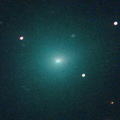
|
Now it is very bright as 10.8 mag (Dec. 5, Thomas Lehmann). It stays 10 mag until winter. It is observable in good condition in the Northern Hemisphere. It locates low in the Southern Hemisphere.
Date(TT) R.A. (2000) Decl. Delta r Elong. m1 Best Time(A, h)
Dec. 9 12 15.17 7 2.6 1.265 1.408 76 11.3 2:53 (248, 18)
Dec. 16 12 34.78 5 51.8 1.245 1.424 78 11.4 2:53 (247, 20)
|
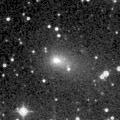
|
Now it is 11.2 mag (Dec. 7, Chris Wyatt). It will stay bright as 11 mag for a long time from winter to next spring. In the Southern Hemisphere, it stays observable in good condition until next February. In the Northern Hemispehre, it stays observable for a long time after this until the comet fades out.
Date(TT) R.A. (2000) Decl. Delta r Elong. m1 Best Time(A, h)
Dec. 9 4 53.59 7 38.5 2.089 3.050 164 11.4 23:39 (180, 47)
Dec. 16 4 44.35 9 30.5 2.062 3.013 161 11.4 23:02 (180, 45)
|

|
It brightened up to 7.1 mag from May to June (June 21, Juan Jose Gonzalez). Now it is fading. It has already faded down to 13.5 mag (Dec. 7, Chris Wyatt). In the Southern Hemisphere, it stays observable for a long time after this. It will never be observable again in the Northern Hemisphere.
Date(TT) R.A. (2000) Decl. Delta r Elong. m1 Best Time(A, h)
Dec. 9 19 56.20 -56 29.9 3.394 2.803 46 12.7 20:51 ( 39, 28)
Dec. 16 20 17.48 -56 2.0 3.490 2.869 44 12.8 20:57 ( 38, 26)
|
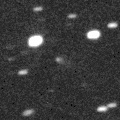
|
Now it is 14.9 mag (Dec. 1, Katsumi Yoshimoto). It will approach to Earth down to 0.2 a.u., and to Sun down to 0.6 a.u., and it is expected to brighten up to 10-11 mag from winter to spring. In the Northern Hemisphre, it stays observable in good condition until January, but it will be extremely low after that. In the Southern Hemisphere, it is not observable from January to mid March, but it stays observable in good condition except for that period.
Date(TT) R.A. (2000) Decl. Delta r Elong. m1 Best Time(A, h)
Dec. 9 8 56.52 1 2.2 0.837 1.575 119 14.1 2:53 (202, 52)
Dec. 16 8 52.58 5 22.0 0.632 1.466 128 13.2 2:53 (188, 50)
|
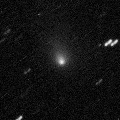
|
It brightened very rapidly from July to August. Now it is very bright as 14.2 mag (Nov. 8, Chris Wyatt). It is observable in excellent condition in the Southern Hemisphere. It stays low for a while in the Northern Hemisphere.
Date(TT) R.A. (2000) Decl. Delta r Elong. m1 Best Time(A, h)
Dec. 9 23 59.32 -25 23.7 2.210 2.453 92 13.4 20:51 (102, 62)
Dec. 16 0 4.07 -23 27.4 2.266 2.428 87 13.3 20:57 ( 99, 55)
|

|
Now it is visible visually at 13.4 mag (Nov. 14, Sandor Szabo).
Date(TT) R.A. (2000) Decl. Delta r Elong. m1 Best Time(A, h)
Dec. 9 21 21.07 -13 7.6 6.206 5.805 61 13.7 20:51 ( 90, 23)
Dec. 16 21 25.09 -12 46.2 6.302 5.804 55 13.7 20:57 ( 86, 17)
|

|
Now it is 14.0 mag (Nov. 28, Toshihiko Ikemura, Hirohisa Sato). It is expected to brighten up to 12 mag from 2018 to 2019. In the Northern Hemisphere, it stays observable in good condition while the comet will be brightening gradually. In the Southern Hemisphere, it is not observable until 2018 October.
Date(TT) R.A. (2000) Decl. Delta r Elong. m1 Best Time(A, h)
Dec. 9 15 29.57 48 55.8 3.631 3.502 74 13.9 2:53 (232,-39)
Dec. 16 15 33.78 49 56.9 3.527 3.458 77 13.8 2:53 (230,-35)
|
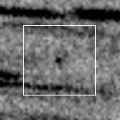
|
It will brighten very rapidly, and brighten up to 11 mag from January to February. In the Northern Hemisphere, it stays observable for a long time in the evening sky. In the Southern Hemisphere, it locates extremely low at the highlight.
Date(TT) R.A. (2000) Decl. Delta r Elong. m1 Best Time(A, h)
Dec. 9 20 3.46 -11 51.1 1.660 1.177 44 14.4 20:51 ( 80, 7)
Dec. 16 20 27.11 -11 23.4 1.620 1.121 42 13.9 20:57 ( 80, 5)
|
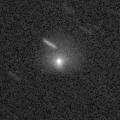
|
Brian Skiff found a bright outburst on Dec. 7. Now it is bright as 13.5 mag (Dec. 7, Richard Miles). This is the 4th outburst following those in January 2006, May 2011 and August 2016. It stays observable in good condition for a while.
Date(TT) R.A. (2000) Decl. Delta r Elong. m1 Best Time(A, h)
Dec. 9 2 39.10 11 26.3 6.478 7.297 143 14.0 21:26 (180, 43)
Dec. 16 2 37.55 11 20.6 6.570 7.315 136 14.3 20:57 (180, 44)
|
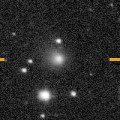
|
Now it is 13.7 mag (Nov. 14, Gabor Santa). It is expected to brighten up to 10 mag in summer in 2018. In the Northern Hemisphere, it stays observable until 2018 summer while the comet will be brightening. However, it will be extremely low from December to January. In the Southern Hemisphere, it is hardly observable in 2017, but it will be observable in good condition in 2018.
Date(TT) R.A. (2000) Decl. Delta r Elong. m1 Best Time(A, h)
Dec. 9 17 55.20 11 56.1 4.217 3.481 37 14.2 20:51 ( 81,-33)
Dec. 16 18 1.84 10 40.7 4.189 3.426 34 14.2 20:57 ( 75,-38)
|

|
Now it is 14.2 mag (Nov. 14, Artyom Novichonok). It will be observable at 14 mag for a long time from 2017 to 2018. In the Southern Hemisphere, it will be hardly observable after this. It will be extremely low from November to December in the Northern Hemisphere.
Date(TT) R.A. (2000) Decl. Delta r Elong. m1 Best Time(A, h)
Dec. 9 16 24.20 20 20.3 4.429 3.785 44 14.6 2:53 (272,-40)
Dec. 16 16 26.86 21 0.5 4.373 3.774 47 14.5 2:53 (268,-35)
|
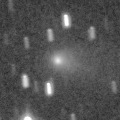
|
Now it is 15.7 mag (Nov. 22, Sandor Szabo). It brightened rapidly. It is observable at 15 mag in autumn in good condition in the Northern Hemisphere. It locates low in the Southern Hemisphere.
Date(TT) R.A. (2000) Decl. Delta r Elong. m1 Best Time(A, h)
Dec. 9 5 21.63 39 57.6 1.143 2.103 162 15.0 0:12 (180, 15)
Dec. 16 5 14.85 40 14.7 1.170 2.130 162 15.1 23:33 (180, 15)
|
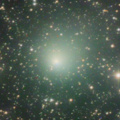
|
It brightened up to 10 mag from spring to summer. Now it is fading. It has already faded down to 14.8 mag (Dec. 4, Thomas Lehmann). It is observable in excellent condition in the Southern Hemisphere. It locates low in the Northern Hemisphere.
Date(TT) R.A. (2000) Decl. Delta r Elong. m1 Best Time(A, h)
Dec. 9 21 48.47 -21 56.6 2.369 2.152 65 15.1 20:51 ( 85, 33)
Dec. 16 22 2.20 -20 25.7 2.476 2.190 61 15.3 20:57 ( 84, 29)
|

|
It brightened up to 11.6 mag in mid October (Oct. 13, Chris Wyatt). It passed the perihelion on Oct. 27. It will not be observable after this.
Date(TT) R.A. (2000) Decl. Delta r Elong. m1 Best Time(A, h)
Dec. 9 17 20.83 -14 5.1 2.116 1.157 9 15.1 20:51 ( 53,-22)
Dec. 16 17 37.25 -14 57.6 2.251 1.286 8 15.8 20:57 ( 49,-24)
|
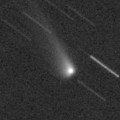
|
Now it is 15.1 mag (Nov. 22, Sandor Szabo). It stays observable at 15-16 mag for a long time from 2017 to 2018.
Date(TT) R.A. (2000) Decl. Delta r Elong. m1 Best Time(A, h)
Dec. 9 0 19.71 3 30.7 3.843 4.267 109 15.2 20:51 (142, 44)
Dec. 16 0 16.08 2 13.8 3.975 4.267 100 15.3 20:57 (131, 40)
|

|
Now it is 14.7 mag (Dec. 7, Chris Wyatt). It stays 15 mag until winter. In the Southern Hemisphere, it stays observable in excellent condition until spring in 2018. In the Northern Hemisphere, it stays unobservable until 2018.
Date(TT) R.A. (2000) Decl. Delta r Elong. m1 Best Time(A, h)
Dec. 9 1 29.12 -59 35.3 1.826 2.026 86 15.4 20:51 ( 11, 65)
Dec. 16 1 33.39 -55 12.4 1.822 2.015 86 15.4 20:57 ( 24, 67)
|
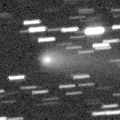
|
It brightened up to 12.2 mag in August (Aug. 21, Juan Jose Gonzalez). It is fading now. It has already faded down to 15.2 mag (Nov. 22, Sandor Szabo).
Date(TT) R.A. (2000) Decl. Delta r Elong. m1 Best Time(A, h)
Dec. 9 8 16.45 11 43.2 1.306 2.103 132 15.5 2:53 (185, 43)
Dec. 16 8 11.13 12 33.3 1.303 2.160 141 15.6 2:34 (180, 43)
|

|
Now it is 16.4 mag (Nov. 23, Toshihiko Ikemura, Hirohisa Sato). It will be observable at 16 mag in good condition from winter to spring.
Date(TT) R.A. (2000) Decl. Delta r Elong. m1 Best Time(A, h)
Dec. 9 11 43.24 9 1.6 3.500 3.541 84 15.7 2:53 (241, 22)
Dec. 16 11 48.00 8 45.5 3.397 3.540 90 15.6 2:53 (237, 26)
|
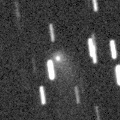
|
Now it is 14.8 mag (Nov. 14, Gabor Santa). In the Northern Hemisphere, it stays 15 mag until winter, and it is observable in excellent condition. It is not observable at all after this in the Southern Hemisphere.
Date(TT) R.A. (2000) Decl. Delta r Elong. m1 Best Time(A, h)
Dec. 9 19 50.35 62 7.1 3.126 3.298 91 15.7 20:51 (147,-32)
Dec. 16 19 54.34 61 55.7 3.169 3.314 89 15.7 20:57 (146,-35)
|

|
Now it is 15.0 mag (Nov. 22, Sandor Szabo). It stays 17 mag in 2018.
Date(TT) R.A. (2000) Decl. Delta r Elong. m1 Best Time(A, h)
Dec. 9 3 17.40 -1 16.8 5.462 6.292 144 15.7 22:04 (180, 56)
Dec. 16 3 15.59 -1 16.8 5.552 6.322 138 15.7 21:35 (180, 56)
|
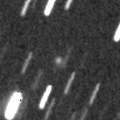
|
Now it is 15.6 mag (Nov. 22, Sandor Szabo). It stays observable at 16 mag for a long time until summer in 2018. It is observable in good condition in the Northern Hemisphere in 2017, and in the Southern Hemisphere in 2018.
Date(TT) R.A. (2000) Decl. Delta r Elong. m1 Best Time(A, h)
Dec. 9 23 38.94 44 25.7 1.283 1.888 111 15.8 20:51 (154, 4)
Dec. 16 23 18.33 36 58.1 1.375 1.836 100 15.8 20:57 (142, 5)
|
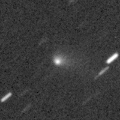
|
It brightened rapidly. Now it is bright as 14.8 mag (Nov. 22, Sandor Szabo). Return of a new periodic comet which brightened up to 13 mag in 2004. It is be observable in excellent condition in autumn. It continues brightening even after the perihelion passage.
Date(TT) R.A. (2000) Decl. Delta r Elong. m1 Best Time(A, h)
Dec. 9 2 15.61 16 3.0 0.926 1.796 140 15.9 21:03 (180, 39)
Dec. 16 2 17.89 17 21.8 0.989 1.816 133 16.1 20:57 (174, 37)
|
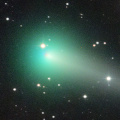
|
It brightened up to 6.2 mag in April (Apr. 7, Juan Jose Gonzalez). Now it is fading rapidly. It has already faded down to 13.5 mag (Nov. 14, Sandor Szabo). It stays observable for a long time after this.
Date(TT) R.A. (2000) Decl. Delta r Elong. m1 Best Time(A, h)
Dec. 9 2 47.60 16 21.4 2.324 3.199 147 15.9 21:34 (180, 39)
Dec. 16 2 44.78 15 59.5 2.464 3.277 139 16.2 21:04 (180, 39)
|

|
Now it is 16.3 mag (Nov. 15, Toshihiko Ikemura, Hirohisa Sato). It stays 16-17 mag for a long time from 2016 to 2019. It stays near by the equator.
Date(TT) R.A. (2000) Decl. Delta r Elong. m1 Best Time(A, h)
Dec. 9 10 33.30 3 55.7 9.377 9.570 98 16.0 2:53 (230, 38)
Dec. 16 10 33.96 3 58.3 9.265 9.572 105 16.0 2:53 (223, 42)
|
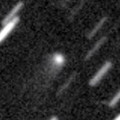
|
Now it is 16.3 mag (Nov. 15, Toshihiko Ikemura, Hirohisa Sato). It stays 16 mag for a long time from 2017 to 2018. It is observable in excellent condition in the Northern Hemisphere. It locates very low in the Southern Hemisphere.
Date(TT) R.A. (2000) Decl. Delta r Elong. m1 Best Time(A, h)
Dec. 9 9 6.46 28 50.6 4.697 5.329 125 16.1 2:53 (195, 25)
Dec. 16 9 1.50 30 14.9 4.605 5.330 133 16.1 2:53 (187, 24)
|

|
Now it is 15.3 mag (Nov. 22, Sandor Szabo). It will be fading after this, and it will be fainter than 18 mag in March.
Date(TT) R.A. (2000) Decl. Delta r Elong. m1 Best Time(A, h)
Dec. 9 0 54.78 17 12.6 2.362 3.001 121 16.5 20:51 (160, 35)
Dec. 16 0 56.44 17 19.1 2.459 3.014 115 16.6 20:57 (151, 32)
|

|
Now it is 16.9 mag (Nov. 20, Toshihiko Ikemura, Hirohisa Sato). It will brighten up to 9 mag in 2018 summer. However, it is hardly observable when it is bright. In the Northern Hemisphere, it is observable only until March when it brightens up to 14 mag. In the Southern Hemisphere, it is observable from July to September in 2018, but it locates in extremely low.
Date(TT) R.A. (2000) Decl. Delta r Elong. m1 Best Time(A, h)
Dec. 9 22 3.65 64 45.0 3.017 3.399 104 16.7 20:51 (157,-20)
Dec. 16 22 14.54 62 21.3 2.973 3.319 101 16.6 20:57 (153,-21)
|

|
Now it is 17.0 mag (Nov. 15, Kunihiro Shima). It will be observable at 16.5 mag in good condition in winter.
Date(TT) R.A. (2000) Decl. Delta r Elong. m1 Best Time(A, h)
Dec. 9 9 55.80 -6 25.8 2.435 2.821 102 16.6 2:53 (229, 51)
Dec. 16 9 58.10 -8 1.4 2.380 2.846 108 16.6 2:53 (222, 56)
|

|
It stays 15 mag from 2018 to 2019, and it will be observable for a long time in the Southern Hemisphere. In the Northern Hemisphere, it will never be observable again.
Date(TT) R.A. (2000) Decl. Delta r Elong. m1 Best Time(A, h)
Dec. 9 13 37.35 -42 35.2 5.916 5.289 46 16.8 2:53 (305, 27)
Dec. 16 13 42.67 -43 53.1 5.813 5.252 51 16.7 2:53 (304, 31)
|

|
Now it is 16.9 mag (Nov. 23, Toshihiko Ikemura, Hirohisa Sato). In the Northern Hemisphere, it will be observable at 17 mag in excellent condition from autumn to winter. It locates low in the Southern Hemisphere.
Date(TT) R.A. (2000) Decl. Delta r Elong. m1 Best Time(A, h)
Dec. 9 5 24.95 36 1.6 2.249 3.213 165 16.7 0:16 (180, 19)
Dec. 16 5 19.49 36 3.4 2.265 3.231 166 16.8 23:38 (180, 19)
|
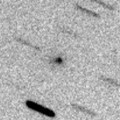
|
Now it is 17.2 mag (Nov. 2, A. Diepvens). It stays observable at 17 mag in good condition for a while. It will be fainter than 18 mag in May.
Date(TT) R.A. (2000) Decl. Delta r Elong. m1 Best Time(A, h)
Dec. 9 13 35.16 -3 32.2 2.542 2.114 53 16.8 2:53 (269, 8)
Dec. 16 13 48.03 -4 26.6 2.503 2.142 57 16.8 2:53 (267, 11)
|

|
Now it is 16.7 mag (Nov. 15, Toshihiko Ikemura, Hirohisa Sato). It will pass the perihelion in 2019. However, it has not been brightening since the discovery in 2010. It is observable in good conditioin in the Northern Hemisphere. It is not observable for a long time in the Southern Hemisphere.
Date(TT) R.A. (2000) Decl. Delta r Elong. m1 Best Time(A, h)
Dec. 9 6 47.13 75 41.6 8.235 8.843 125 16.8 1:39 (180,-21)
Dec. 16 6 39.87 76 7.0 8.209 8.831 126 16.8 1:04 (180,-21)
|

|
Now it is 16.6 mag (Sept. 16, P. Camilleri, H. Williams). It will brighten up to 14 mag from autumn to winter in 2018, and it will be observable in excellent condition in the Northern Hemisphere. In 2017, it is observable at 17 mag in excellent condition in the Southern Hemisphere.
Date(TT) R.A. (2000) Decl. Delta r Elong. m1 Best Time(A, h)
Dec. 9 22 59.33 -33 29.8 3.570 3.482 76 17.1 20:51 ( 79, 52)
Dec. 16 23 2.18 -31 49.8 3.620 3.438 71 17.1 20:57 ( 78, 45)
|

|
Now it is 17.8 mag (Nov. 20, Toshihiko Ikemura, Hirohisa Sato). It will be fading slowly after this.
Date(TT) R.A. (2000) Decl. Delta r Elong. m1 Best Time(A, h)
Dec. 9 11 51.72 -11 14.3 2.885 2.789 74 17.3 2:53 (260, 33)
Dec. 16 11 55.87 -11 58.3 2.838 2.842 80 17.3 2:53 (257, 38)
|
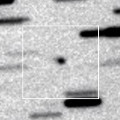
|
Now it is 17.3 mag (Nov. 24, Toshihiko Ikemura, Hirohisa Sato). It stays observable at 18 mag for a long time until 2019.
Date(TT) R.A. (2000) Decl. Delta r Elong. m1 Best Time(A, h)
Dec. 9 6 32.46 18 50.0 7.050 7.975 158 17.8 1:23 (180, 36)
Dec. 16 6 26.60 18 37.7 7.009 7.971 166 17.7 0:49 (180, 36)
|

|
Now it is 17.8 mag (Nov. 23, H. Nohara). It was observed at 17 mag in former 2017. It will be observable at 18 mag in good condition from winter to spring.
Date(TT) R.A. (2000) Decl. Delta r Elong. m1 Best Time(A, h)
Dec. 9 12 52.65 1 5.9 5.601 5.266 65 18.0 2:53 (259, 14)
Dec. 16 12 53.82 1 47.1 5.497 5.284 72 17.9 2:53 (254, 19)
|

|
Possible first interstellar object in the history. It approached to Sun down to 0.25 a.u. on Sept. 9. Now it is fading rapidly. It was 19.0 mag in mid October (Oct. 14, Catalina Sky Survey). But it has already fade down to 24.3 mag (Nov. 17, W. H. Ryan, E. V. Ryan).
Date(TT) R.A. (2000) Decl. Delta r Elong. m1 Best Time(A, h)
Dec. 9 23 19.73 7 34.1 2.042 2.369 96 26.4 20:51 (130, 32)
Dec. 16 23 22.58 8 1.4 2.306 2.517 90 26.7 20:57 (123, 27)
|
|
![]()
 C/2016 T3 ( PanSTARRS )
C/2016 T3 ( PanSTARRS ) C/2017 B3 ( LINEAR )
C/2017 B3 ( LINEAR ) 90P/Gehrels 1
90P/Gehrels 1 30P/Reinmuth 1
30P/Reinmuth 1 C/2010 U3 ( Boattini )
C/2010 U3 ( Boattini ) (944) Hidalgo
(944) Hidalgo 103P/Hartley 2
103P/Hartley 2 C/2015 XY1 ( Lemmon )
C/2015 XY1 ( Lemmon ) C/2017 D3 ( ATLAS )
C/2017 D3 ( ATLAS ) 1I/2017 U1 ( 'Oumuamua )
1I/2017 U1 ( 'Oumuamua )![]()




































